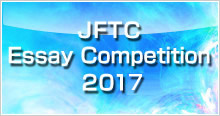Remarks by Selection Committee Chair, Dr. Iwao NAKATANI
After the success of the first JFTC Essay Competition last year, a total of 118 exciting essays were sent to us this year. I am personally most delighted and pleased to find that 68 of those essays were submitted by people of foreign nationality (most of those essays were in English). Moreover, the non-Japanese participants hailed from five continents and were from a wide range of countries, including Norway, Germany, France, Poland, Spain, Slovakia, United States, Canada, Australia, New Zealand, Brazil, Mexico, Venezuela, Honduras, Iran, Philippines, Pakistan, Indonesia, Malaysia, Vietnam, India, Korea, China, Nigeria, Kenya, Uganda, and Ghana. It is unprecedented in Japan for an essay contest to receive such worldwide participation. The fact that we were able to attract contestants from truly every corner of the globe is the result of the efforts of the Selection Committee. As chairman of the Selection Committee, I would like to take this opportunity to thank them all.
The theme of this year's competition was “The Potential of Brand Japan.” How is Japan's brand perceived? Where does its brand value lie? How should its brand value be developed in the future? The essays vigorously debated these issues. According to most essays, Japanese are highly respected for their culture, sensitivity and high-quality craftsmanship, but many essays also expressed concern about Japan's foreign policy in relation to China, the closed nature of Japanese society, and the nation's ability to innovate with the aging of society as well as decline in the birthrate.
The Grand Prize was granted to Erik Magnus HAUAN for his “The Potential of Brand Japan.” Mr. HAUAN is a 25-year-old Norwegian graduate student living in Denmark. Drawing on his experience of living in Japan, he posited that the uniqueness of Brand Japan lies in the cultural sensitivity it demonstrates. Mr. HAUAN then went on to offer the following two proposals regarding how Japan could develop greater brand value as a country in the future. First, he suggested Japan improve its relations with China and its other neighbors. Second, he proposed that Japan be more active in addressing global warming and other environmental issues because the nation possesses advanced environmental technology. The main reason why all the judges recommended this essay for the Grand Prize was the author's well-balanced writing capability and high level of understanding about Japan. Mr. HAUAN's straightforward writing style was well received by all the members of the Selection Committee. The argument was lucid, and the proposals were appropriate.
The Prize for Excellence was awarded to “ Shu-Ha-Ri ” (守破離) by Daisuke SUGIYAMA (age 26), “The Cornerstone of 'Japan-Brand': The Tradition of Succession and Transformation, and the Future of This Practice” by Yoshimi SUGANO (age 49), and “Building Depth into 'Brand Japan '” by Hideki SATO (age 38).
In “ Shu-Ha-Ri, ” Daisuke SUGIYAMA proposes that Brand Japan is based in the “ Shu-Ha-Ri ” principle found in kendo which he took up when he was living in New York. This very ambitious essay strongly impressed the judges with the strength of the writer's conviction. In “The Cornerstone of 'Japan-Brand': The Tradition of Succession and Transformation, and the Future of This Practice,” Yoshimi SUGANO persuasively argues that a framework must be developed on the national level to refine Japan's culture, tradition, and master craftsmanship which all lie behind Brand Japan. In “Building Depth into 'Brand Japan,'” Hideki SATO makes the novel proposal that we should strengthen Japanese people's ability to communicate in order to convey the value of Brand Japan to the rest of the world. Each of these three essays was equally distinctive so that it was difficult for the Selection Committee to rank them properly.

